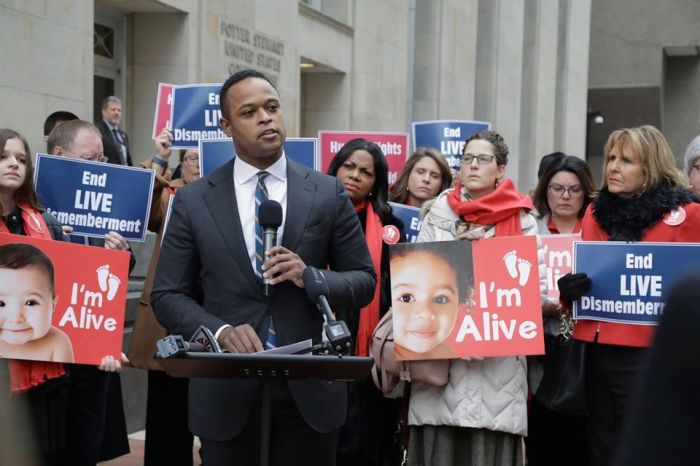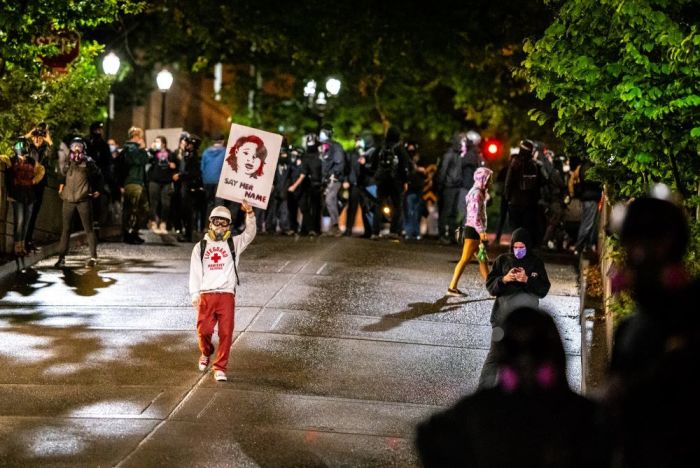Kentucky AG to release grand jury recordings in Breonna Taylor case after juror files motion

Kentucky Attorney General Daniel Cameron said Monday that he will release the recording of secret grand jury proceedings that considered charges against three white Louisville police officers in the fatal shooting of Breonna Taylor inside her apartment in March.
The decision came after an unnamed juror, who argued that Cameron misrepresented the grand jury’s deliberations in his announcement last week, filed a court motion seeking a release of the recording as well as permission to speak publicly to set the record straight.
Cameron said in a statement published by CBS News that even though the grand jury proceedings are meant to be secret, he would comply with a judge’s order to release the recording by Wednesday.
"The Grand Jury is meant to be a secretive body," Cameron said. "It's apparent that the public interest in this case isn't going to allow that to happen."
The juror argued that Cameron did not give the grand jury the option of indicting the two of the officers involved in Taylor’s fatal shooting.
“This is something where the juror is not seeking any fame, any acclaim, any money,” Kevin M. Glogower, the juror’s lawyer, told The New York Times.
On Monday, Cameron said that his team presented jurors with a "thorough and complete case.”
“Our prosecutors presented all of the evidence, even though the evidence supported that Sergeant [Jonathan] Mattingly and Detective [Myles] Cosgrove were justified in their use of force after having been fired upon by Kenneth Walker,” Cameron said in a statement shared with media outlets. “For that reason, the only charge recommended was wanton endangerment.”

The attorney general announced last Wednesday that while the shooting death of Taylor, a 26-year-old black woman, was tragic, the evidence considered in the case could not indict any of the three officers — Jonathan Mattingly, Brett Hankison and Myles Cosgrove — for her death.
They were involved in the fatal shooting incident after breaking into Taylor’s apartment to execute a no-knock search warrant related to a narcotics probe involving Taylor’s ex-boyfriend, Jamarcus Glover, on March 13.
Hankison was charged with three counts of wanton endangerment of people in a neighboring apartment, a Class D felony. None of the officers were presented with any charges related to Taylor, who was struck by six bullets.
In his detailing of the facts in the case, Cameron said that in the early morning hours of March 13, the officers went to Taylor’s apartment to execute the warrant and were advised by superiors to knock and announce their presence in serving it.
The officers said they both knocked and announced their presence at the apartment, contrary to earlier accusations that they hadn’t announced their presence. Their announcement was corroborated by an independent witness who was near Taylor’s apartment. However, other residents have also said they did not hear the police announce themselves.
When no one answered, the officers breached the door. They said Mattingly was the first, and only, officer to enter the residence.
He identified two individuals standing beside one another at the end of the hall, a male and female.
The male who was identified as Taylor’s boyfriend, Kenneth Walker, was holding a gun, arms extended, in a shooting stance.
Mattingly saw the man’s gun go off, heard a “boom”, and immediately knew he was shot because he felt heat in his upper thigh.
It was concluded that Walker fired the shot that hit Mattingly and there is no evidence to support that injury by friendly fire from the other officers.
Walker admitted that he fired one shot and was the first to shoot.
The ballistics report also shows that the round that struck Mattingly was fired from a 9 mm handgun. The officers fired .40 caliber handguns. However, one of Walker’s attorney, Steve Romines, said last Wednesday that he had obtained a Louisville Metro Police Department record that shows that Hankison was issued a 9 mm gun, according to USA Today.
Mattingly returned fire after releasing six shots.
Cosgrove, who was also in the doorway area, shot 16 times. Evidence shows that only one of Taylor’s six bullet wounds were fatal.
Hankison also fired his weapon 10 times, including from outside a sliding-glass door and through a bedroom window.
Some bullets traveled through the walls and two other apartments. In one of those apartments, a male, pregnant female and a child were at home.
The attorney general’s investigation found that Mattingly and Cosgrove were justified in their use of force, after having been fired upon by Walker.
“The KSP ballistics analysis did not identify which of the three officers fired the fatal shot,” a statement from the attorney general’s office reads. “The FBI Crime Lab was asked to conduct an analysis to see if their analysis reached the same results. The FBI ballistics analysis concluded that the fatal shot was fired by Detective Cosgrove.”
“[Special Prosecution Unit] looked at both reports to determine if there were major differences in the procedures used by each lab that would have led the FBI to identify who fired the fatal shot,” the statement continues. “Both law enforcement agencies used similar equipment and analysis, but issued different findings.”
The attorney general’s office contends that different conclusions create a “reasonable doubt in the evidence about who fired the fatal shot.”
Glogower told The New York Times that the juror was unsettled by the fact that the grand jury was presented only with possible charges for Hankison, who was fired in June, but not charges for Mattingly or Cosgrove.
Legal experts had explained to the newspaper, however, that Kentucky’s vigorous self-defense laws made it unlikely that murder charges would be filed against any of the officers because Walker had fired first.
“We have no concerns with grand jurors sharing their thoughts on our presentation because we are confident in the case we presented,” Elizabeth Kuhn, a spokeswoman for the attorney general, told the New York Times on Monday.
“Our prosecutors presented all of the evidence, even though the evidence supported that Sergeant Mattingly and Detective Cosgrove were justified in their use of force after having been fired upon by Kenneth Walker. For that reason, the only charge recommended was wanton endangerment.”
Ramon McGee, a longtime criminal defense lawyer, said the charges the attorney general presented to the grand jury was not problematic.
“That is an incorrect assumption on how the grand jury process works,” he said. “Prosecutors make the decision on what witnesses are called, which evidence is tendered and what charges to recommend.”
Benjamin Crump, attorney for Taylor’s family, told CBS News that there were concerns with the investigation.
Crump said his team had spoken with 12 witnesses who say they did not hear officers announce themselves during the execution of the warrant.
"Daniel Cameron only presented his perspective and didn't present the other 12 neighbors’ [perspective],” Crump said. “He has unilaterally made a decision on whether or not Breonna Taylor would ever get due process, whether she would ever get justice, and that is not right.”





























